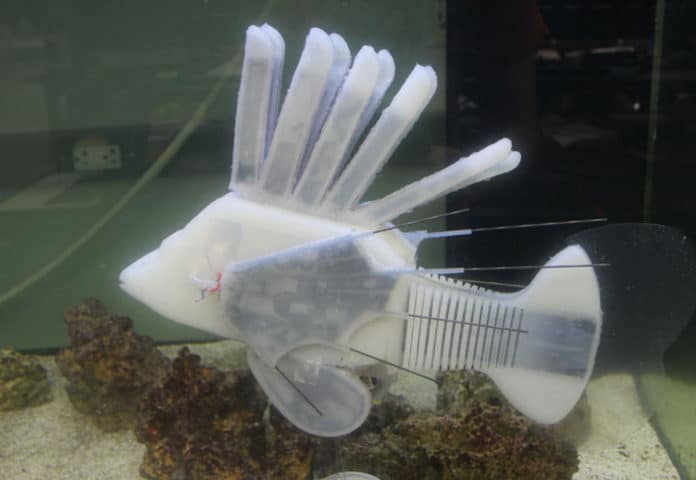Soft robots are always good, they can be very useful in search operations. Also, we have seen many animal-inspired robots like energy-efficient SlothBot that moves only when it must to measure environmental changes.
Now, a team of researchers at Cornell University has created a robotic fish powered by a battery fluid that the team called ‘robot blood,’ taking a highly innovative pathway to create better autonomous robots.
A new roughly 40-centimeter robotic lionfish can swim around using the synthetic circulatory system, which pumps artificial blood made of battery fluid, around to its various components and motors. Instead of the solid batteries, it is propelled by a dual-function fluid that stores energy and moves the fish’s fins.
The dual function liquid incorporates really tiny batteries throughout the robotic fish and operates with two pumps – one for the pectoral fins and the second for the tail. In this way, the liquid and the pumps act as a heart, circulating the “blood.” This kind of approach allows the machine to store more energy in a smaller space and operate for longer periods without the need for heavy and cumbersome battery packs.
One of the key challenges in robotics is to make robots autonomous for extended periods of time. These long life robots could have various applications like search and rescue missions and in deep-sea exploration. But the robot needs enough power to perform tasks without having to recharge. Adding batteries could increase the weight of the robot, so it requires more power to move.
Instead of conventional hydraulic fluid, Robo-Fish uses a battery fluid that powered the robot and also powered a pump to move the fins, making the fish swim. It helps the robot reach a top speed of 0.1 inches per second. It can fan its pectoral fins and swim at a speed of more than 1.5 body lengths per minute, which is around 15 centimeters per minute or around 0.01 kilometers per hour.
“Hydraulic fluid transmits force and only force,” said Cornell roboticist Robert Shepherd. “In our fluid, we’re transmitting force and we’re transmitting electrical power.”
In the team’s research, the synthetic blood allows the robot to store 325 percent more energy than if it was carrying a separate battery pack. The team says that the robot would be able to function for 37 hours without requiring recharging. Robo-fish cannot swim very fast or far, but it can set a good example of how mimicking biological organisms could help a new generation of robots to become more autonomous and efficient than ever before.
That issue of slowness can be fixed, says Robert Shepherd, by increasing the surface area of the batteries.
The research is published in the journal Nature.
